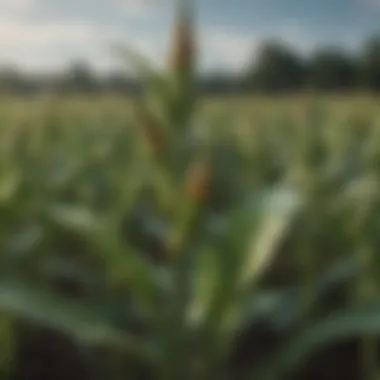Lady Finger Seeds: Insights on Cultivation and Value


Summary of Objectives
This article aims to explore lady finger seeds in depth. It provides an overview of their botanical characteristics, cultivation methods, nutritional value, and market significance. Through detailed analysis, the reader will gain insights into the various facets related to the growing of lady finger, including its environmental requirements and economic impact across different regions.
Importance of the Research
Understanding lady finger seeds is crucial for researchers and agricultural professionals. The rise in demand for nutritious food sources emphasizes the need for effective cultivation practices. This article serves as a vital resource to enhance knowledge in the academic community and agriculture sectors.
Prolusion
Lady finger, widely recognized as okra, is a popular vegetable known for its unique texture and nutritional benefits. It is cultivated extensively in warm climates across the globe. The seeds of lady finger are significant, as they play a crucial role in the growth of the plant. This section delves into the various aspects surrounding lady finger seeds, their characteristics, and their overall importance in agricultural practices.
Lady finger seeds are characterized by their small, oval shape and smooth surface. These seeds are relatively easy to cultivate, making them an attractive choice for farmers. Understanding the requirements of these seeds is vital for successful cultivation.
Results and Discussion
Presentation of Findings
One notable finding in our exploration of lady finger seeds is their adaptability to diverse soil types. They prefer well-drained soil with a pH level between 6.0 and 6.8. Proper spacing during planting is crucial to ensure good air circulation and sunlight exposure, allowing optimal growth.
Lady finger plants require a warm climate to thrive, as cooler temperatures can stunt their growth. Furthermore, regular watering and maintenance can significantly influence the yield of lady finger crops. Adequate fertilization with nitrogen-rich fertilizers can enhance productivity and increase the quality of the okra produced.
Implications of Results
The insights gathered from this research highlight the economic importance of lady finger cultivation in various regions. In areas where agriculture is a primary source of livelihood, the successful cultivation of lady finger can lead to improved income for farmers. Additionally, lady finger's nutritional benefits contribute to food security, making it an essential crop in sustainable agriculture.
"The successful growth of lady finger not only addresses nutritional needs but also supports local economies, making it a valuable crop in many regions."
In summary, a comprehensive understanding of lady finger seeds, their cultivation practices, and the associated environmental requirements is essential for those involved in agriculture. By delving into the dynamics of this vegetable, we can better appreciate its role in both local and global contexts.
Understanding Lady Finger Seeds
Lady finger seeds, commonly known as okra seeds, play a pivotal role in both agriculture and nutrition. Understanding these seeds is essential for anyone involved in cultivation or research, as they provide unique insights into the plant's growth potential and adaptability. This section aims to emphasize the significance of lady finger seeds in farming, their characteristics, and the advantages they present.
- Importance in Agriculture:
Lady finger seeds are a critical component of crop rotation systems, enhancing soil health and pest management. Farmers value them for their resilience and ability to thrive in diverse environmental conditions. - Nutritional Benefits:
Beyond cultivation, lady fingers are known for their numerous health benefits. They are rich in vitamins and minerals, making them a valued vegetable in various culinary traditions. - Economic Considerations:
The demand for organic and locally-sourced produce continues to increase. Understanding lady finger seeds helps in optimizing production methods and ensuring market supply aligns with this demand.
"The use of quality seeds results in healthier plants, leading to better yield and improved nutritional profiles of the produce."
Botanical Classification
Lady finger, scientifically known as Abelmoschus esculentus, belongs to the Malvaceae family. This classification underscores the plant's relationship with other species within the same family. The classification is essential for researchers and farmers alike, as it has implications for hybridization and breeding programs. Understanding the plant's taxonomy provides context for its growth conditions, pest resistance, and care requirements.
Morphological Characteristics
The morphological characteristics of lady finger seeds offer insights into their growth potential.
- Seed Size and Shape:
Lady finger seeds are typically flat and oval, ranging from about 1 to 2 centimeters in length. This unique shape aids in germination and optimal nutrient absorption. - Seed Color:
They usually exhibit a light tan to dark brown color, which helps in the identification and sorting during the planting process. - Germination Capacity:
High-quality seeds demonstrate a germination rate above 80%. This is vital for ensuring a successful crop yield, reflecting the importance of seed selection practices.
Understanding these characteristics is fundamental for effective cultivation practices, as they play a significant role in the overall health and productivity of the plants.
Seed Selection Practices
Seed selection is the pinnacle of successful lady finger cultivation. Choosing the right seeds ensures healthy plants which yield abundant fruits. This process reduces the potential for disease and enhances overall resilience in various environments. Moreover, seeds are the root of the entire cultivation cycle, guiding the eventual quality and quantity of the harvest. Adequate attention and research into seed selection can significantly affect both productivity and profitability for farmers.
Criteria for Quality Seeds
Identifying quality seeds is fundamental for optimal growth. Several criteria must be considered:
- Viability: Seeds should demonstrate a high germination rate. This indicates that they can grow into healthy plants. A common threshold is a germination rate of at least 85%.
- Purity: Seeds must be free from contaminants, including pathogens and pests. Cross-contamination can lead to significant failures in the cultivation cycle.
- Physical Condition: Seeds should be firm and without any signs of damage. Cracks or discoloration may indicate that the seed is old or not viable.
- Source: Reputable vendors who provide detailed information about their seed quality can increase trustworthiness in the seed selection process.
These elements encompass the foundation of why specific seeds perform better than others in varying conditions.
Sources for Acquiring Seeds
Acquiring seeds from trusted sources contributes to effective seed selection. Farmers and gardeners can consider various avenues for sourcing seeds:
- Local Nurseries: Often, local nurseries offer seeds that are well-adapted to the regional climate. This local knowledge can prove invaluable for growers.
- Seed Companies: Organizations like Baker Creek Heirloom Seeds provide a wide variety of seeds, including specialty ones. They usually offer warranties on seed quality, ensuring a reliable growth cycle.
- Online Markets: Platforms such as Amazon and eBay can provide access to both local and international seed varieties. However, care is needed to vet sellers and ensure quality.
- Community Exchanges: Participating in seed exchanges with other local cultivators not only reduces costs but also encourages the sharing of unique varieties.
In summary, thoughtful seed selection practices pave the way for successful lady finger cultivation. By understanding the criteria for quality seeds and exploring various sources for acquisition, growers enhance the probability of a productive yield.
Cultivation Techniques
Understanding cultivation techniques is essential for the successful growth of lady finger seeds, commonly known as okra. Proper techniques not only enhance crop yield but also contribute to healthier plants and soil management. Notably, cultivation methods encompass soil preparation, sowing methods, and irrigation practices, each playing a pivotal role in the growth cycle.
Soil Preparation and Management
Soil preparation is a foundational step in the cultivation of lady finger. It involves assessing and improving soil quality to create an optimal growing environment. This step typically includes soil testing to determine pH levels and nutrient content, which informs amendments such as organic compost or fertilizers specific to the needs of lady finger.
Good soil management practices promote effective water retention and drainage. For lady finger, a slightly acidic to neutral pH, ideally between 6.0 and 7.0, is crucial. Implementing crop rotation and cover cropping can also maintain soil health and fertility, minimizing the risk of nutrient depletion.
Sowing Methods
The sowing methods employed significantly affect the growth and yield of lady finger. The two primary methods are direct seeding and transplanting. Both methods have their unique characteristics and outcomes.


Direct Seeding
Direct seeding involves sowing seeds directly into the soil. This method is a more straightforward approach and has several benefits. A key aspect of direct seeding is its simplicity and lower labor costs. It allows seeds to germinate in their final location, reducing transplant shock and ensuring a more robust root development. The exposure to natural soil conditions from the outset can be beneficial for the seedling's adaptation to the local environment.
Despite these advantages, direct seeding requires careful timing. Soil temperatures must be warm enough to ensure germination, typically above 18°C. If conditions are unsuitable, there can be issues with seedling establishment.
Transplanting
Transplanting involves growing seedlings in a controlled environment before moving them to the final growing location. This method can be particularly advantageous in regions with unpredictable climates. A key characteristic of transplanting is the ability to control the growing conditions, which can lead to stronger and healthier plants at the time of field planting.
Transplanting allows for an earlier start to the growing season since seedlings can be nurtured in ideal conditions prior to being placed outdoors. However, it requires more initial effort and resources, such as trays, soil, and care for young plants. Additionally, careful handling during transplants is necessary to avoid damaging the delicate roots.
Irrigation Practices
An essential component of successful cultivation is adequate irrigation practices. Lady finger thrives in well-watered soil, especially during dry conditions. It is vital to implement effective irrigation systems to ensure plants receive sufficient moisture without oversaturation, which can lead to root rot.
Drip irrigation is one effective method that minimizes water wastage and delivers moisture directly to the root zone. Alternatively, sprinkler systems can be employed, especially in larger fields. Monitoring soil moisture levels can guide irrigation frequency to maintain optimal growing conditions.
Employing proper cultivation techniques is not just about enhancing yield; it is about fostering sustainable agricultural practices that respect the ecosystem.
Growth and Development Phases
Understanding the growth and development phases of lady finger, or okra, is critical for successful cultivation. Each stage impacts the yield, with various factors influencing growth, including environmental conditions, soil quality, and water availability. Recognizing these phases helps farmers and researchers optimize practices to enhance productivity and manage the health of the plants effectively.
Germination Process
The germination process is the first key phase in the growth cycle. It begins when the seeds absorb water and swell. After that, they break through their seed coat. Temperature plays a significant role here, as seeds typically require a warm environment to germinate properly. For lady finger seeds, a temperature of about 25 to 30 degrees Celsius is ideal.
During germination, the seed utilizes stored nutrients to fuel early growth. Ensuring the right moisture level in the soil is crucial to support this process. If the soil is too dry, seeds may fail to germinate. Conversely, overly wet conditions can lead to rot. Proper seed bed preparation also contributes to a successful germination process, allowing seeds to establish a robust root system.
Vegetative Stage
Following germination, plants enter the vegetative stage, where they focus on leaf and stem development. This phase is vital as it sets the foundation for flowering and fruiting later. Typically lasting several weeks, the vegetative stage can be affected by factors such as light, water, and nutrients.
During this time, adequate nitrogen levels are important to support healthy leaf development. Farmers often analyze soil nutrient levels to optimize fertilization practices, ensuring plants have the necessary resources to thrive. The robust growth of the vegetative stage is crucial, as healthy plants have a better chance of producing more fruit. Monitoring for pests or diseases during this time is also essential, as they can affect plant health and overall yield.
Flowering and Fruiting
The flowering and fruiting stage marks the culmination of the growth and development process. This phase begins when the plants start to develop flowers, which are essential for fruit formation. Proper pollination is crucial for successful fruit set. Thus, it is important to attract pollinators, such as bees, to the fields.
Once pollination occurs, the flowers develop into pods, consisting of the lady finger fruits. Harvesting these pods at the right time is essential to maximize quality and quantity. Generally, the fruits should be picked when they are young and tender, as this is when they are most enjoyable to eat. The flowering and fruiting stage is not only critical for yield but also impacts market value. Farmers must be vigilant at this stage to address any diseases or pests that may threaten the crop.
"The growth and development phases of lady finger are interdependent, each stage requiring careful monitoring and management to ensure a successful harvest."
Environmental Requirements
Understanding the environmental requirements of lady finger seeds is crucial for successful cultivation. The right conditions not only facilitate growth but also enhance the overall yield. It involves various elements like temperature, climate, pH levels, and soil quality. Each of these factors has specific roles in ensuring the optimal development of lady finger plants. Recognizing their importance can lead to more effective farming practices and better economic returns.
Temperature and Climate Needs
Lady finger or okra thrives in warm climates. Ideally, the ambient temperature should range from 70°F to 95°F. This temperature range supports both germination and subsequent growth phases. Cold weather can stunt growth or lead to failures in germination. In regions where temperatures drop, using protective covering or greenhouses can be beneficial.
Moreover, lady finger plants require good sunlight. At least six hours of direct sunlight each day is necessary for healthy growth. Sunlight aids in the photosynthesis process, promoting vigorous flowering and fruiting stages. Additionally, humidity levels should be moderate. Too much moisture can promote fungal diseases, whereas very dry air might stress the plants. Proper balance is key.
pH and Soil Quality
The quality of soil is another vital aspect for lady finger cultivation. The ideal soil pH for lady finger is between 6.0 and 6.8. This range supports efficient nutrient absorption, ensuring plants receive essential elements for growth. Soil testing should be conducted before planting to assess pH levels and nutritional content. If the pH is off, amendments can be applied to correct it.
Soil texture also matters. A loamy or sandy soil mix is preferable as it drains well while retaining necessary moisture. Heavy clay soils may lead to root rot, while overly sandy soils can lead to water loss. Adding organic matter, like compost, can improve soil structure and fertility. This promotes healthy root development and overall plant vigor.
Important Note: Soil health plays a significant role in pest and disease resistance. Healthy soil fosters robust plants, reducing the likelihood of infestations and infections.
In summary, understanding these environmental requirements is key to cultivating lady finger successfully. Proper temperature maintenance and maintenance of soil pH can lead to fruitful outcomes. Each farmer should monitor these elements to optimize their cultivation practices.
Pest and Disease Management
Pest and disease management is a critical aspect of lady finger cultivation, impacting both the yield and quality of the produce. Effective management strategies are essential to prevent potential losses caused by various pests and diseases that can affect the lady finger, or okra, crop. This section explains common pests and disease prevention strategies.
Common Pests Affecting Lady Finger
Lady finger plants are susceptible to numerous pests that can damage both foliage and fruits. One of the most prevalent pests is the aphid. These small insects feed on plant sap, leading to stunted growth and reduced yield. Another common pest includes the cutworm, which can cut seedlings at the ground level, causing significant loss. Additionally, the spider mite can cause foliage damage, creating stippling on leaves. Here are some of the key pests:
- Aphids: Feed on the sap, weakening the plant.
- Cutworms: Attack seedlings, leading to their death.
- Spider Mites: Cause leaf stippling and reduced photosynthesis.
- Whiteflies: Suck sap from the underside of leaves, leading to yellowing.
Understanding these pests enables farmers to act swiftly to mitigate damage. This often includes monitoring plant health regularly and employing integrated pest management techniques.
Disease Prevention Strategies
Preventing diseases in lady finger crops is essential for maintaining a healthy plant and optimising crop yield. There are several strategies that farmers can implement:
- Crop Rotation: Rotating crops can break the cycle of diseases that are soil-borne.
- Proper Spacing: Adequate space between plants improves air circulation, reducing the risk of fungal infections.
- Disease-Resistant Varieties: Selecting seeds that have resistance to specific diseases can greatly enhance crop resilience.
- Sanitation Practices: Removing debris and practicing good hygiene can help prevent the spread of pathogens.
"An ounce of prevention is worth a pound of cure."
This saying applies strongly in agriculture. Early detection and intervention can save crops from major infestations or outbreaks. Consistent monitoring, good cultural practices, and proper education about potential threats can lead to successful lady finger cultivation. By combining these strategies, farmers can ensure a robust yield and safeguard against the negative impacts of pests and diseases.


Harvesting Methods
Harvesting methods are crucial in the cultivation of lady finger seeds. Effective harvesting affects both the yield and the quality of the produce, which in turn influences marketability. Knowing when and how to harvest can assure optimal growth and development outcomes.
Timing for Optimal Harvest
The timing of the harvest is critical. Lady finger, or okra, is generally ready for harvest 50 to 60 days after sowing. It is vital to observe the pods closely. They should be picked when they are young and tender, typically measuring 4 to 5 inches in length. Waiting too long can result in tough and fibrous pods, which are less desirable. Harvesting at the right time maximizes flavor and nutritional value.
Pro tips for determining the best timing include:
- Observe the color: The pods should be a vibrant green.
- Feel the texture: Tender pods yield easily when slight pressure is applied.
- Check the size: Consistently measure pod size to ensure uniformity.
By picking the pods regularly every two or three days, growers can stimulate further production. This practice not only ensures fresh produce but also enhances overall yield.
"Harvesting at the peak of ripeness ensures the best taste and texture, influencing consumer preference significantly."
Techniques for Harvesting
Different techniques exist for harvesting lady finger. The most common and recommended method is hand harvesting. This method minimizes damage to the plants and surrounding pods. Here are some key steps:
- Wear gloves: This helps prevent skin irritation from the pods.
- Use pruning shears if necessary: For pods that are hard to reach, shears can ensure a clean cut and avoid damage to the plant.
- Handle with care: Gently twist the pods to detach them from the plant while avoiding breakage.
In contrast, mechanical harvesting is an option for larger-scale farms, but it requires careful calibration to avoid damaging the crop. Some think also of using specific harvesters designed for okra varieties.
Considerations for successful harvesting include assessing weather conditions. Avoid harvesting in wet conditions, as this can result in spoilage and increased susceptibility to diseases. Proper and timely harvesting methods can also reduce post-harvest losses, maintaining the economic viability of growing lady finger.
Post-Harvest Handling
Post-harvest handling is a crucial step in the cultivation process of lady finger, also known as okra. Once harvested, proper handling ensures the quality, flavor, and nutritional integrity of the product. Inadequate post-harvest practices can lead to significant losses, both economically and nutritionally. Therefore, understanding the essentials of storage and packaging is vital for optimizing the longevity of lady finger.
Storage Conditions
Optimal storage conditions for lady finger seeds significantly impact their viability and quality. Lady finger should be stored in a cool, dry place. Temperature control is important; ideally, the temperature should not exceed 20°C. Humidity levels should also be monitored closely, as high moisture content can lead to fungal growth and seed spoilage.
Key factors to consider when determining storage conditions:
- Temperature: Maintain a stable environment. Fluctuations can cause condensation, damaging the seeds.
- Humidity: Aim for a relative humidity of around 50%. Excess moisture is harmful.
- Ventilation: Ensure good air circulation to prevent moisture build-up.
- Darkness: Store seeds away from direct sunlight to protect them from degradation.
Choosing appropriate storage containers is equally critical. Using breathable bags or containers helps in maintaining the required conditions. Avoid plastic bags, which can trap moisture and promote decay.
Packaging Techniques
Effective packaging is essential for the protection of lady finger seeds during transport and storage. The choice of packaging materials can greatly influence the seed's longevity and condition. To start with, packaging should be designed to protect against moisture, pests, and physical damage.
Consider the following packaging techniques:
- Material Selection: Use materials such as Kraft paper, burlap or breathable fabric. These materials allow for air exchange while keeping moisture at bay.
- Labeling: Clearly label packages with information on the seed variety, harvest date, and storage instructions. This promotes proper management and traceability.
- Sealing: If using plastic for packaging, ensure it is vacuum-sealed to remove air and reduce humidity levels within the package.
- Transport Considerations: Avoid stacking heavy items on top of seed packages during transportation to minimize crushing or pressure damage.
Proper post-harvest handling practices ultimately enhance seed quality, leading to better germination rates and better crop yields.
Nutritional Value of Lady Finger
Lady finger, commonly known as okra, is not only a versatile vegetable in culinary applications but also a rich source of nutrients. Understanding its nutritional value is crucial as it informs consumers about the health benefits that come from including this vegetable in their diets. In this section, we will delve into the specific vitamins and minerals found in lady finger, as well as the broader health benefits associated with its consumption.
Vitamins and Minerals
Lady finger is particularly rich in essential vitamins and minerals. Here are some key components:
- Vitamins: Lady finger contains significant amounts of Vitamin C, which plays a vital role in maintaining skin health and enhancing the immune system. It also includes Vitamin A, important for eye health, as well as folate, which is essential for cellular function and tissue growth.
- Minerals: The vegetable is a good source of calcium and potassium. Calcium contributes to maintaining bone health, while potassium aids in regulating blood pressure and fluid balance. Magnesim and iron are also present, supporting various bodily functions like energy production and oxygen transport.
"Incorporating lady finger into the diet can provide a significant boost to daily vitamin and mineral intake, promoting overall health."
These nutrients all work together to contribute to the vegetable's value, making it an excellent addition to both vegetarian and meat-based dishes.
Health Benefits
The health benefits of consuming lady finger are numerous, making it a valuable food choice. Some notable advantages include:
- Digestive Health: Lady finger is high in dietary fiber, which aids in digestion by promoting regular bowel movements and preventing constipation.
- Weight Management: Low in calories but high in fiber, lady finger can aid in weight management, as it provides satiety without excessive caloric intake.
- Blood Sugar Regulation: The vegetable may contribute to lowering blood sugar levels, making it beneficial for those managing diabetes.
- Heart Health: The combination of potassium and calcium supports heart health by helping to regulate blood pressure levels.
Economic Importance
The economic significance of lady finger seeds is profound, influencing various sectors from agriculture to healthcare. Lady finger, also known as okra, is a vital crop in many countries, not only for its culinary value but also for its nutritional contributions and economic viability. Understanding its economic impact can provide insights into agricultural trends, income generation, and sustainability in farming.
Market Demand Analysis
The demand for lady finger is growing due to its popularity in cuisines across the globe. As consumer preferences shift towards healthier food options, lady finger presents itself as a nutritious vegetable, rich in vitamins and minerals. Examination of markets indicates a steady increase in consumption both domestically and internationally.
Several factors contribute to the heightened market demand:
- Nutritional Awareness: Lady finger is rich in dietary fiber and essential vitamins like A, C, and K, appealing to health-conscious consumers.
- Culinary Versatility: It can be cooked in various ways, making it a staple in many culinary traditions, especially in regions like South Asia, Africa, and the southern United States.
- Urbanization and Dietary Changes: Urban areas show an increased demand for fresh vegetables, including lady finger, as consumers seek easy-to-cook and nutritious food options.
This market growth presents significant opportunities for farmers as well as agribusinesses. However, the fluctuating prices and the need for consistent quality are challenges that need addressing. Understanding buyer preferences become crucial in tapping into the market effectively.


Export Potential
Lady finger also holds considerable export potential. Countries that produce excess yield can leverage international markets for additional revenue. The export journey of lady finger involves various factors:
- Global Market Trends: By analyzing global demand, especially in North America and Europe, exporters can strategize their supply chains accordingly.
- Quality Standards: Complying with international quality norms is essential for successful exports. This means investing in good agricultural practices and post-harvest handling.
- Trade Agreements: Understanding and utilizing trade agreements can facilitate easier access to foreign markets, making it more profitable for farmers.
Cultural Significance
The cultural significance of lady finger, also known as okra, extends far beyond its existence as a mere vegetable. This plant is integral to various culinary traditions and culture in different regions of the world. The way the plant is grown, prepared, and consumed embodies specific practices and rituals, making it deeply rooted in the cultural identity of many communities. Understanding these elements sheds light on not just the agricultural value of okra, but also its pivotal role within cultural contexts.
Culinary Uses
Lady finger is widely appreciated for its unique texture and flavor, playing a significant role in numerous cuisines. It is often used in curries, soups, and stir-fries, enriching dishes with its versatile nature. In Indian cuisine, for example, lady finger is a key ingredient in popular recipes such as Bhindi Masala, where it is sautéed with spices, creating a flavorful dish that is enjoyed alongside rice or chapati.
In the Southern United States, okra is famously used in gumbo, a hearty stew that highlights its slimy yet tender qualities. This culinary application not only emphasizes the vegetable's unique performance as a thickening agent but also showcases how ingredients change depending on local preferences and traditions.
Here are a few notable culinary uses of lady finger:
- Stir-fried with spices
- Pickled as a tangy side dish
- Added to stews for thickening
- Used in salads for a crunchy element
The methods of preparation and the contexts in which lady finger is served underline its cultural importance across diverse communities. It acts as a medium through which traditions are passed down and celebrated.
Traditional Practices
The cultivation and harvesting of lady finger are often accompanied by various traditional practices, enriching its significance. In many cultures, the planting season aligns with specific festivals or celebrations, thereby intertwining agriculture with community rituals. In some regions of Africa, for instance, communities may gather for collective planting, reinforcing social bonds and shared responsibility toward food production.
Traditionally, how lady finger is harvested can also reflect cultural attitudes toward agriculture. Some communities emphasize sustainable practices that respect the land, preserving not just okra but the environment for future generations. In contrast, others may lean towards more commercial methods, prioritizing yield but at the risk of local biodiversity.
Moreover, the storage and sharing of harvested crops often foster a sense of community. Farmers may share their produce with neighbors or during communal meals, reinforcing social ties and cultural narratives that honor the role of food as a communal resource.
The significance of these cultural elements is essential for researchers and educators to understand not just the biological and economic aspects of lady finger but also its broader role in nurturing community identity, tradition, and sustainability.
"Lady finger symbolizes more than just nutrition; it embodies cultural heritage and community connection within agricultural practices."
Challenges in Cultivation
The cultivation of lady finger, also known as okra, presents several challenges that can affect both yield and quality. Recognizing these hurdles is vital for researchers, educators, and growers who seek to optimize production and enhance marketability. This section examines key challenges such as climate change impacts and socio-economic barriers, emphasizing their implications on cultivation practices.
Climate Change Impact
Climate change poses a significant threat to agricultural systems, including the cultivation of lady finger. This vegetable is sensitive to fluctuations in temperature and rainfall patterns. In regions where okra is grown, changes in climate can lead to several undesirable effects. For instance, increased temperatures may cause heat stress, leading to reduced flowering and fruit set. As the growing season becomes less predictable, risk of crop failure increases.
Furthermore, erratic rainfall can impact soil moisture levels, crucial for germination and plant growth. Too much water can lead to root rot, while insufficient rainfall can hinder germination. Farmers often struggle to adapt to these irregular weather patterns, which makes planning and resource allocation challenging.
Moreover, pests and diseases may intensify due to climate change. Warmer temperatures could expand the range of pests that affect lady finger, while also increasing the likelihood of outbreaks of certain diseases. This scenario creates a cycle of challenges that can be difficult for farmers to navigate.
Socio-economic Barriers
Socio-economic factors are equally important in the context of lady finger cultivation. Many farmers face financial constraints that limit their access to quality seeds, fertilizers, and modern farming techniques. This situation can lead to sub-optimal yields and affect the overall market supply of okra.
Additionally, lack of awareness and education about best cultivation practices can exacerbate the situation. In developing regions, many farmers rely on traditional knowledge that may not align with scientific advancements in agricultural practices. This knowledge gap can result in reduced efficiency and productivity in their farming operations.
Access to markets is another crucial socio-economic consideration. In many areas, farmers struggle with inadequate infrastructure, making it difficult to transport their produce to consumers. Without proper channels for distribution, growers may face challenges in selling their goods, ultimately affecting their livelihood.
"Understanding socio-economic conditions and climate change impacts is crucial for developing effective strategies to enhance okra cultivation in varying contexts."
In summary, while lady finger is a valuable crop, several challenges can impede its successful cultivation. Both climate change and socio-economic barriers require attention and innovative solutions to promote sustainable growing practices. Addressing these issues could lead to improved yields and better economic outcomes for farmers.
Future Directions in Research
The field of lady finger seed cultivation is evolving. Future research is essential to enhance both the qualitative and quantitative aspects of okra production. Renewed focus on genetic improvement strategies and sustainable farming practices can lead to increased productivity and resilience against changing environmental conditions. Research in this area is not just a theoretical endeavor; it holds practical implications for farmers and consumers alike.
Genetic Improvement Strategies
Genetic improvement is pivotal in addressing the challenges that come with traditional farming of lady finger. Advancements in biotechnology and genetic engineering allow for the development of seeds that are more resistant to pests, diseases, and environmental stresses. The application of marker-assisted selection can facilitate this process, making it easier to breed varieties that demonstrate desirable traits.
- Increased Yield: With improved genetics, crop yield can significantly rise, providing more produce for markets.
- Nutritional Enhancement: Research can also focus on biofortifying lady finger with essential vitamins and minerals that can lead to an increase in overall health benefits for consumers.
- Disease Resistance: Developing seed varieties that can withstand diseases, such as powdery mildew and root rot, is critical for sustainable production.
Additionally, involving farmers in the research process ensures that the developed varieties are practical and meet market needs. This approach creates a feedback loop that can guide further improvements.
Sustainable Farming Practices
Sustainable farming practices must be part of the dialogue surrounding the cultivation of lady finger. As the agriculture sector faces increasing pressure from climate change and resource scarcity, integrating sustainability practices into the farming community becomes imperative. These practices are not merely ecological; they also carry economic benefits.
- Crop Rotation: Rotating lady finger with other crops can improve soil health and reduce the likelihood of pest infestations.
- Organic Farming: Utilizing organic methods to manage pest control can lead to safer products and potentially higher market value.
- Water Management: Adopting efficient irrigation techniques like drip irrigation can conserve water and improve crop yields.
Educational initiatives that encourage farmers to adopt these practices will play a critical role in sustainability. Enhanced training on these methodologies can help in promoting environmental stewardship while ensuring economic returns.
Investing in research for genetic improvement and sustainable farming practices can lead to significant advances in the production of lady finger, impacting food security and economic stability in farming communities.
Culmination
In this article, the discussion on lady finger seeds has covered various aspects that contribute to a comprehensive understanding of both their cultivation and significance. Recognizing the importance of lady finger, also known as okra, goes beyond mere agricultural practices. It intertwines with nutritional, market, and cultural dimensions. The conclusion synthesizes critical insights from previous sections, reinforcing how these elements collectively enhance our perception of lady finger as a valuable crop.
The benefits of cultivating lady finger seeds are manifold. First, they provide essential nutrients, making them a staple in diverse diets. Their relatively simple cultivation process also invites farmers, especially in regions with adequate climate, to engage in sustainable farming practices. Proper understanding of pest and disease management strategies ensures healthy growth, reducing reliance on chemical interventions. Environmental considerations, coupled with awareness of socio-economic barriers, further emphasize the need for thoughtful integration of agricultural techniques.
Moreover, the economic importance highlighted throughout the article serves to establish lady finger as a crop with high market demand both locally and internationally. This observation underscores the potential for farmers to enhance their livelihoods. Such insights create a rationale for further investment in research and development. This research is essential for genetic improvements and pursuing sustainable farming practices to meet future food security challenges.
"A comprehensive understanding of lady finger cultivation not only supports agricultural sustainability but also catalyzes economic growth in farming communities."
Thus, the conclusion stresses that the topic of lady finger seeds encapsulates an interplay of science, health, and economy. By fostering an informed approach towards cultivating this crop, stakeholders can contribute positively to food systems and biodiversity preservation, aligning agricultural endeavors with contemporary global challenges.















